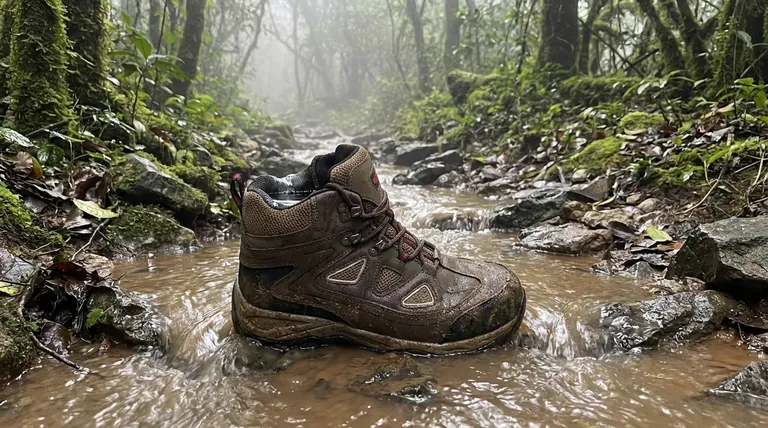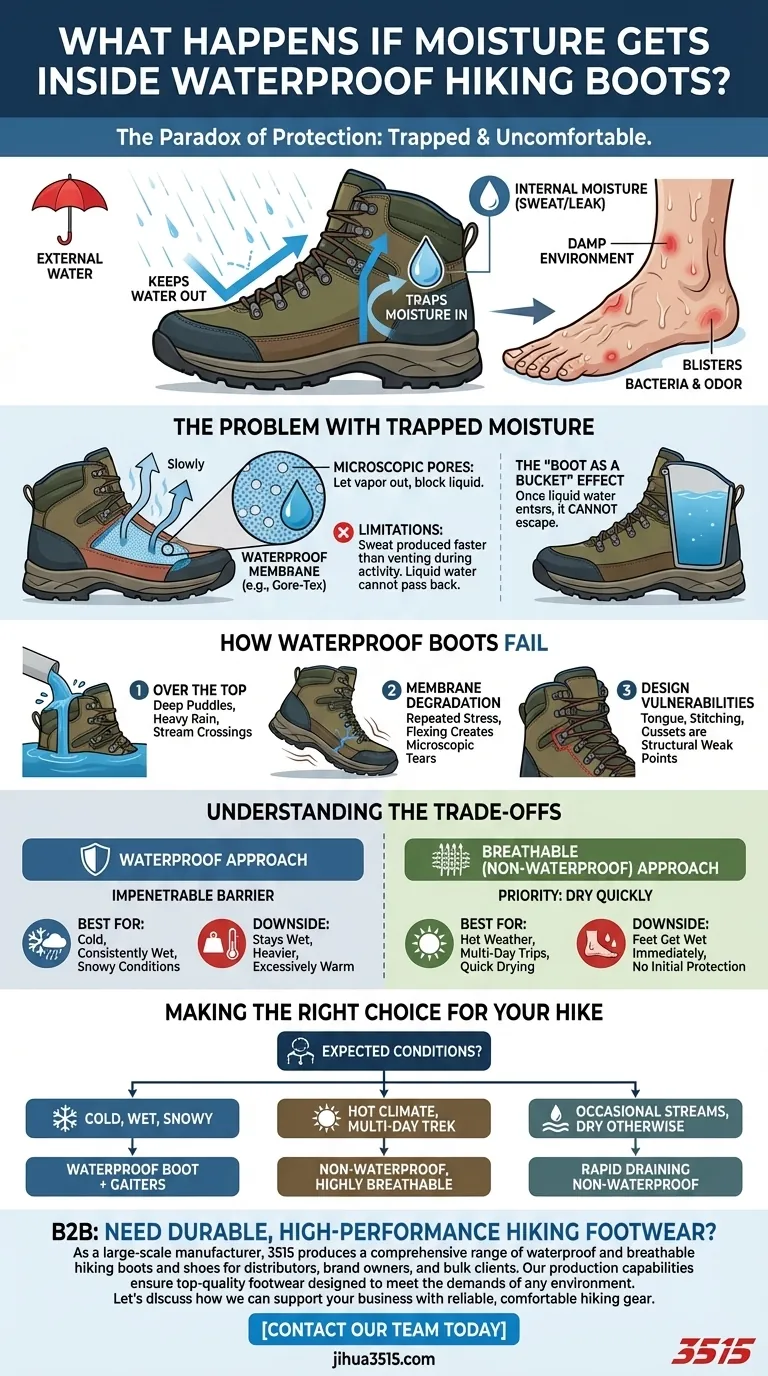Once moisture gets inside a waterproof hiking boot, it becomes trapped. The very waterproof membrane designed to keep external water out also works in reverse, making it extremely difficult for internal moisture—whether from sweat or a leak—to escape. This creates a damp, uncomfortable environment for your foot that typically persists for the remainder of your hike.
The core paradox of a waterproof boot is that its greatest strength becomes its most significant liability once breached. The impermeable barrier that protects you from rain and puddles also prevents the boot from draining and drying effectively, trapping moisture against your skin.

The Problem with Trapped Moisture
Modern waterproof boots rely on a specialized membrane, like Gore-Tex, built with microscopic pores. These pores are large enough to let water vapor (sweat) out but too small for liquid water droplets to get in. However, this system has practical limitations.
How "Breathability" Fails
The process of moving water vapor out of the boot is slow and relies on a pressure and temperature differential. During strenuous activity, your foot produces sweat faster than the membrane can vent it.
When liquid water from an external source gets inside—for instance, by seeping over the top of the boot in a deep puddle—it cannot pass back through the membrane. The boot effectively becomes a bucket.
The Impact on Your Feet
Trapped moisture inside a boot leads to several negative consequences. It significantly softens the skin, making it far more susceptible to blisters and chafing.
Furthermore, a persistently damp environment is an ideal breeding ground for bacteria, which can lead to unpleasant odors and potential foot health issues over time.
How Waterproof Boots Fail
Understanding that no boot is permanently impervious is key. Moisture inevitably finds a way in through one of three primary failure points.
1. Over the Top
The most common entry point for water has nothing to do with the boot's construction. Water from deep puddles, stream crossings, or heavy rain running down your legs will simply pour in over the boot's collar.
2. Membrane Degradation
The waterproof membrane is a thin layer that gets flexed millions of times, especially in the forefoot area where your foot bends. Over time, this repeated stress can create microscopic tears, compromising its integrity and allowing water to seep through.
3. Design Vulnerabilities
Not all parts of a boot are equally protected. The tongue area, with its complex stitching and gussets, is often a structural weak point where waterproofing can be less effective or fail sooner than in other parts of the boot.
Understanding the Trade-offs: Waterproof vs. Non-Waterproof
The issue of trapped moisture forces a critical choice between two different philosophies of foot comfort on the trail.
The Waterproof Approach
A waterproof boot aims to create an impenetrable barrier to keep your foot completely dry from external elements.
- Best For: Day hikes in cold, consistently wet, or snowy conditions where preventing initial water entry is the highest priority.
- The Downside: Once wet inside, they stay wet for a very long time, are typically heavier, and can be excessively warm in hot climates.
The Breathable (Non-Waterproof) Approach
A non-waterproof boot accepts that your feet will get wet in certain conditions and instead prioritizes the ability to dry out as quickly as possible.
- Best For: Hot weather hiking, multi-day trips where drying gear overnight is crucial, and environments with frequent but shallow stream crossings.
- The Downside: Your feet will get wet immediately when submerged or during a downpour, offering no initial protection from water.
Making the Right Choice for Your Hike
There is no single "best" type of boot; the optimal choice depends entirely on the conditions you expect to face.
- If your primary focus is keeping feet dry in cold, snowy, or consistently damp weather: A waterproof boot is the right tool, but pair it with gaiters to prevent water from entering over the top.
- If your primary focus is multi-day trekking or hiking in warm climates: A non-waterproof, highly breathable boot or trail runner will provide superior long-term comfort by drying quickly.
- If your primary focus is crossing occasional streams in otherwise dry conditions: A non-waterproof boot that can drain and dry rapidly is often more comfortable than a waterproof boot that risks trapping water inside.
Ultimately, choosing the right footwear means matching the technology's inherent limitations to the reality of your environment.
Summary Table:
| Aspect | Waterproof Boots | Non-Waterproof Boots |
|---|---|---|
| Primary Goal | Keep external water out | Drain and dry quickly |
| Best For | Cold, wet, snowy conditions | Hot weather, multi-day trips |
| Key Downside | Traps moisture inside once wet | No initial protection from water |
Need Durable, High-Performance Hiking Footwear for Your Customers?
As a large-scale manufacturer, 3515 produces a comprehensive range of waterproof and breathable hiking boots and shoes for distributors, brand owners, and bulk clients. Our production capabilities ensure top-quality footwear designed to meet the demands of any environment. Let's discuss how we can support your business with reliable, comfortable hiking gear.
Contact our team today to explore partnership opportunities!
Visual Guide

Related Products
- Safety Footwear Wholesale Manufacturer for Custom OEM/ODM Production
- High Performance Fire-Retardant Waterproof Safety Boots
- Premium Wholesale Waterproof Safety Boots High Performance Protection for Industrial Markets
- Factory Direct Wholesale Rain Boots Durable Waterproof & Fully Customizable
- Premium Flame-Retardant Waterproof Safety Boots and Shoes
People Also Ask
- What do heavy duty boots do? Protect Your Feet in Demanding Work Environments
- What are the cultural perspectives on wearing shoes in the house? A Guide to Home Etiquette & Hygiene
- How long can you wear safety boots? The Lifespan is Determined by Wear, Not Time
- What are the differences between steel toe, composite toe, and alloy toe Wellington boots? Choose the Right Safety Toe for Your Job
- What are OSHA approved shoes? Understanding the Correct Standards for Workplace Safety



















